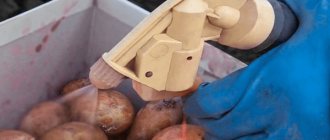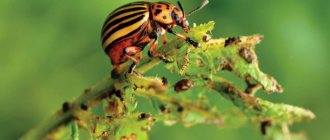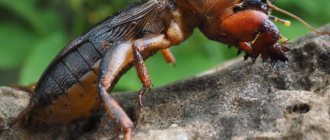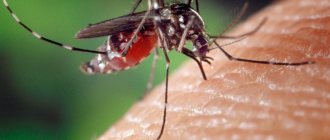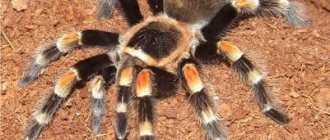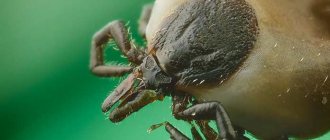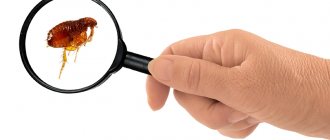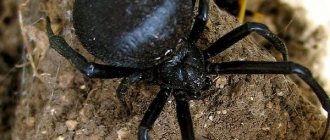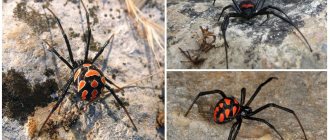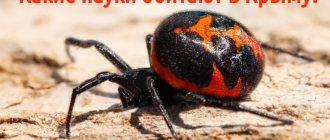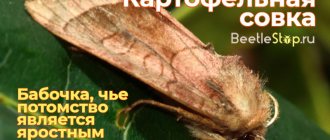Colorado beetle
This native of distant America, unfortunately, is familiar to absolutely everyone who grows potatoes. The striped aggressor from the family of leaf beetles really liked our climate. Beetles and larvae of the Colorado potato beetle feed on the leaves of representatives of the nightshades: potatoes, tomatoes, eggplants, which makes them dangerous agricultural pests.
- Which bugs in the garden should you definitely get rid of: top 7 pests
Unfortunately, many of the flying and crawling guests of your garden appeared on the site with not the best intentions. We study pest beetles.
This insect goes deep into the soil for the winter, and in the spring it comes out and begins to actively eat the first greenery. Even if you carefully monitor your plot, your potatoes are in danger. This insect actively moves, so it is not difficult for it to travel a hundred meters in the air from a neighboring infected garden to yours.
Plants damaged by the Colorado potato beetle simply dry out, because... lose their ability to absorb moisture and nutrients from the soil.
During a season, the pest can produce several generations (females lay eggs without interruption), and under unfavorable conditions, it can even hibernate for up to three years.
Appearance and symptoms of the presence of the Colorado potato beetle
Externally, the adult insect is a classic “beetle” up to 12 mm long, with a yellow head, a round body and shiny convex elytra with longitudinal stripes. Its larvae are about the same size, bright orange with a black head and two rows of black dots on the sides of the body.
Due to their similar appearance, the harmful larvae of the Colorado potato beetle are often confused with the larvae of the extremely beneficial ladybug. Be careful - the latter are gray, “spiny” with orange spots.
It is easy to detect the Colorado potato beetle; you just need to look closely at the potato leaves. On them (most often along the edges) you can easily notice characteristic traces of the presence of a beetle and its larvae: parts of the leaf have been gnawed off. The larvae feed by moving from the edge of the leaf to its center, gradually destroying the entire leaf blade. At the same time, if you turn over the whole leaves, you can see the beetle’s oviposition from below (many orange eggs tightly located to each other).
Measures to combat the Colorado potato beetle
It is not easy to fight the Colorado potato beetle and its larvae - the pest shows high resistance to poisons and quickly develops immunity to them, and is also poisonous to most birds and animals.
Preventive measures include strict adherence to crop rotation, annual deep autumn digging of the site, planting wormwood, calendula, onions, and hemlock near the potato beds.
If insects have already appeared, you will have to try very hard and apply comprehensive measures. This includes manual collection of beetles and larvae with their destruction outside the site, placement of traps with potato peelings, treatment of crops with folk remedies (birch tar solution, a mixture of soap and ash), as well as the use of chemical insecticides (Fitoverm, Aktara, Corado, Golden Iskra, etc. .P.).
- Which remedies for the Colorado potato beetle to choose - a review of popular drugs
Many people collect the Colorado potato beetle by hand. But what if the area is large and there are a lot of insects? Use chemicals!
Prevention of potato pests
Vegetable growers have to constantly fight potato pests. But prevention is the most effective option against potato parasites on the site. You need to start protecting the crop with planting material. There is a large selection of drugs. They differ in their operating principle, price, volume, and degree of danger. Ways to use protective equipment:
- Processing potato tubers before planting. You can take “Prestige” or “Taboo”. The drug is applied directly to the tubers or the solution is added to the wells. A solution of potassium permanganate or wood ash is a substitute for chemicals.
- Deep plowing of the site in the fall. This technique destroys the larvae of pests that have gone to winter.
- Hilling up, high-quality weeding of potatoes. Hilling the tops does not allow many parasites to reach the bush; loosening the soil at this moment destroys young individuals. Weeding gets rid of weeds that serve as habitats or breeding grounds for many pests.
- Growing plants with a repellent odor along the edges of potato beds - marigolds, dill, basil.
- Add 0.5 cups of wood ash to the holes to repel insect pests.
It should be noted that you should not limit yourself to one method; you need to fight comprehensively.
Some visual information:
Medvedka
This large omnivorous insect is sometimes popularly called “earthen crayfish” for the shape and size of its front legs. Mole cricket is dangerous for absolutely all plants in the garden. This pest eats or damages root vegetables, potatoes, roots and bulbs of flowers, shrubs and trees. Both adults and larvae are capable of digging their burrows near plant seedlings and dragging them underground to eat.
An insect can enter a site either on its own or with imported fertilizer or soil. The mole cricket leads an underground lifestyle, eating everything it comes across on the way to digging its passages and holes. It also overwinters in the soil, in the spring it lays eggs in earthen chambers, and after a couple of weeks larvae are born, which will develop for several years.
The mole cricket reproduces quickly, laying one and a half to two hundred eggs at a time, and quickly gets used to pest control medications.
Appearance and symptoms of the presence of a mole cricket
An adult mole cricket is a large (up to 5 cm) big-eyed brown-brown insect with large front paws-claws. She runs fast, moves actively underground, and can fly and swim.
Mole cricket larvae are similar to adult individuals, only smaller in size and slower. As they grow, they feed on the same resources, increasing trouble in the garden beds.
The appearance of a mole cricket in an area can be detected by the sudden wilting of seedlings and the surface of the soil, dotted with small holes and loose mounds that appear in places where the insect moves.
Measures to combat the mole cricket
Measures to prevent the appearance of mole crickets include planting plants with a strong smell (marigolds, calendula), sifting purchased soil and manure, and following the rules of agricultural technology.
If insects have already appeared on the site, you will have to fight them - and, unfortunately, this will take quite a long time. Some even believe that it is impossible to completely remove mole crickets from the garden.
You can place a variety of traps on the territory (containers with beer or honey, piles of manure). Boiling water, an infusion of onion peels or soapy water are poured into the discovered holes made by mole crickets in the ground, or calcium carbide is poured (after rain it will enter into a chemical reaction with water, releasing acetylene gas, which is poisonous to the insect).
Of the proven chemical insecticides against mole crickets, we can recommend Terradox, Discharge, Medvegon, Grom, Rubezh, Rofatox, Rembek, etc., which are laid out in holes during planting of seedlings.
- How to deal with mole crickets - effective drugs and folk remedies
Don’t know how to get rid of mole crickets on your property? Our recipes will help you protect your garden crops from this underground pest.
Why plant other crops next to potatoes?
Other plants near potatoes are good helpers in the fight against various pests. Firstly, if these plants have a strong odor, then they interrupt the smell of potatoes, which insects flock to. They have already been discussed above. Secondly, some of them enrich the crops planted next to them with certain nutrients. Thirdly, there are plants that do not allow pests to live even underground, for example, mustard. She would like to pay special attention.
Mustard is an enemy of underground pests
Mustard not only keeps wireworms and slugs away from potatoes, but also disperses weeds, suppresses late blight and retains moisture in the soil.
Mustard must be cut as soon as it reaches the potato bush
Green fertilizer is sown densely in row spacing in 1 - 2 rows of 300 g of seeds per hundred square meters. Planting depth is 3 cm, then the seeds are sprinkled with soil, watered abundantly and mulched. When the mustard is equal to the potato bush, it is cut off. So, it will not interfere with the development of the main crop, and the yield will not decrease.
Click beetle and its wireworm larva
Strictly speaking, there are many species of click beetles. And not all of them are dangerous for your garden. But we will talk specifically about the latter, which themselves feed on young tubers and leaves of potatoes, and lay eggs, from which real dangerous pests of agricultural crops emerge - larvae, nicknamed wireworms for their appearance.
The beetles lay their eggs in the soil in early to mid-summer, and the hatching larvae overwinter several times before pupating and developing into adult insects, becoming especially harmful to plants when they are older.
Wireworms gnaw long straight passages in tubers. Damaged plants become easy prey for parasites and diseases, are practically impossible to store, and lose their marketable appearance. If wireworms dominate the area, it is impossible to grow healthy root crops even with the use of strong chemicals.
Appearance and symptoms of wireworm presence
The beetles themselves are brown insects with an elongated body, clearly divided into a cephalothorax and abdomen. They received their name for their remarkable ability, being turned on their back, to independently turn over with a jump with a sharp clicking sound.
The beetle larvae are small, dense, yellow-white “worms” that darken with age to an orange-brown color with a dark head and a hard, chitinized cover. During the growth period, wireworms actively move in search of food and feed on underground plant organs.
It is quite simple to determine whether an area is infested with these larvae by the presence of tubers damaged in this way.
Measures to combat wireworms
The fight against wireworms begins with prevention: do not thicken the crops, observe crop rotation, promptly remove weeds (especially wheatgrass) and plant debris, lime the soil, preventing it from acidifying and caking.
Biological methods of getting rid of wireworms mainly include installing traps and baits based on natural products. Every day, the containers need to be cleaned of accumulated larvae and “charged” again, and this will have to be done all summer. You can also use folk remedies to repel pests - onion peels, mustard powder, pine needles, potassium permanganate, etc. A good result is achieved by introducing predatory ground beetles into the area, if possible.
If the number of wireworms is too large, you can treat the soil against pests with chemicals (Zemlin). However, it is not recommended to plant anything in the treated area for some time.
- 10 ways to deal with wireworms
Find out what wireworm looks like and how to effectively fight it.
Aphid
The worst potato pest, the aphid, is found in all regions. In nature, there are hundreds of varieties of this insect, differing in biological parameters. The potato aphid is a small insect, about 2-3 mm in size, greenish in color with a dark head. There are individuals with and without wings, each group has its own functionality (reproduction or movement).
Insects feed on plant sap and live in colonies on the underside of leaf blades. When potatoes are damaged, the upper tier of leaves begins to curl and dry out. The bushes wither, which reduces the crop yield. Aphids secrete honeydew, which the ants feed on and attracts flies. Sooty fungi quickly form on the leaves.
This species of aphid is polyphagous, feeding on the sap of a wide variety of crops. With a massive invasion of aphids, the threat hangs not only over potato beds, but also over plantings of tomatoes, eggplants, cabbage, cucumbers, zucchini, and roses. The danger of the pest also lies in the fact that aphids spread a large number of different viruses, infecting healthy potato plantings.
Potato moth (fluorimea)
The potato moth is a historical neighbor of the Colorado potato beetle. In its homeland in America, it (or rather its caterpillars) has long been, since the times of ancient Indian civilizations, damaging potato tubers stored for storage. And only in the twentieth century did it “enter the world stage.”
This quarantine pest is nocturnal as an adult. The moth lays eggs on the underside of plant leaves (mainly from the Solanaceae family); the eggs hatch into larvae that begin to actively gnaw on the leaf blades. When the potato tops dry out, the caterpillars descend into the tubers and literally tear them up from the inside.
The pest overwinters in the open air in the form of an imago or pupa under plant debris in the upper layers of the soil, as well as in tuber storage facilities - at all stages of development.
The main reservoir of potato moths is precisely potato storage facilities, where insects actively continue their development, damaging tubers and thereby contributing to their rotting.
Appearance and symptoms of potato moth
An adult moth insect is a small butterfly of an inconspicuous brownish-gray color with long antennae and a wingspan of up to 15 mm. The active period is from April to October.
One female during her short life (just a few days) can lay up to 200 eggs, from which yellowish caterpillars emerge, reaching 13 mm in length in the last stages. The pupae are brown, enclosed in silver-gray cocoons.
In case of massive infestation, it is not difficult to notice traces of the presence of potato moth - the leaves of the plants in the beds are nibbled, the tops are drooping, the stems and leaves are shrouded in a white “web” (mainly in the upper part), the tubers are deeply penetrated by winding passages.
Measures to combat potato moth
Prevention and biological control measures against potato moth include the use of only healthy planting material, destruction of weeds, timely high hilling of bushes, harvesting before the tops dry out, storing only healthy undamaged tubers, as well as spraying vegetative plants with Entobacterin (50- 100 g per 10 liters of water) with an interval of 6-8 days.
Chemical measures - after detection of butterflies, immediate treatment of potato bushes with preparations: Inta-Vir, Inta-Ts-M, Molniya Extra, Shar Pei, etc. The interval between treatments is 10-15 days.
Nematodes
The worst pest of potatoes (see photo) is the microscopic golden nematode. The worms, about 1 mm long, live in the soil for about 8-10 years. They overwinter as eggs and larvae in cysts, and when warmer, they penetrate into the root system of plants. Feeding on plant tissues and juices, they grow to adult individuals, which, after fertilization, lay eggs inside themselves and then die. There are several types of nematodes:
- gall - damages the roots of the crop, potatoes in the ground;
- stem - affects the ground part of plants, appears on tubers during storage;
- soil - parasitizes the roots of potatoes.
When affected by a nematode, the bushes stop growing and turn yellow. During the flowering phase, the buds are small or absent, tubers are not formed. The pest appears when agricultural practices are violated, there is no crop rotation on the site, or when planting infected seed material
Damage to potatoes and people
The black spank insect eats potatoes, as well as beets and some other types of garden crops. It is a typical garden and vegetable pest, which, in a massive attack on crops, can cause great harm to plants (potatoes, beets, legumes). Young seedlings that have been actively eaten by the pest begin to get sick and may even dry out. After potato tops are gnawed by beetles, the yield from the bush is noticeably reduced. If you do not take action, then in 2-3 days the pests can eat a potato bush, leaving a lonely stem sticking out.
Important!
The black-headed spandex is also a poisonous insect. At the slightest danger, the beetle releases yellow blood from the joints on its legs - a toxic liquid that helps protect itself from enemies. Its main component is cantharidin, a substance that can cause painful abscesses on the surface of the skin of living organisms, which gradually turn into watery ulcers and blisters, and in humans it contributes to the development of cystitis.
Preventive measures
Following correct agricultural practices will help preserve the harvest and prevent the appearance of pests in the potato field.
- Maintaining crop rotation. Different nightshade crops cannot be planted for several seasons in a row in one area. Also, do not place them next to each other.
- In the spring, it is necessary to properly prepare the soil (dig up, loosen, apply fertilizers and stimulants) and planting material (it must be of high quality, preventively treated, for example, with potassium permanganate, an insecto-fungicidal mordant such as “Prestige”).
- After the end of the season, you need to carefully remove all plant debris from the beds, dig up and disinfect the soil so that pests and their larvae cannot survive the winter.
- During the growing season, it is necessary to fight weeds, hill up plantings, and manually collect single specimens of emerging pests.
- To repel pests, you can use simple folk methods:
- scattering of ash, tobacco dust;
- watering and spraying with a solution of copper sulfate, Bordeaux mixture.
Cicadas
They belong to the family of hemiptera jumping insects of small size (from 1 to 3 centimeters).
They live in anthills during the day, and at night they come out to drink the juice of the plant under the protection of ants, making holes in the plant with their piercing sucking mouth. Rot and pathogens penetrate into these holes with corresponding consequences.
Leafhoppers transmit phytoplasma and viral plant diseases. Parts of damaged plants, after the work of the leafhopper, wither and die.
Cicadas
Cutworm caterpillars
The potato cutworm is an enemy of many plant crops. This is a butterfly whose caterpillars intensively eat plants such as potatoes, tomatoes, garlic, raspberries, lilies, strawberries, corn, iris, rhubarb, onions, hops, beets, cabbage, and cucumbers. It belongs to the noctuid family.
Their caterpillars feed on stems, leaves and rhizomes . They do this at night, living up to their name.
Cutworm caterpillar
